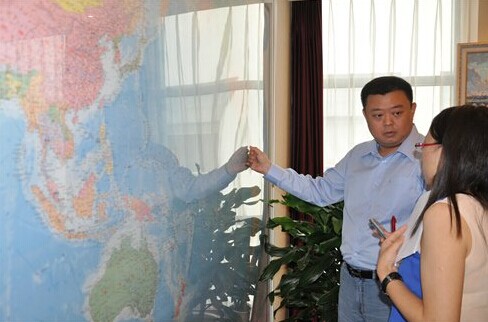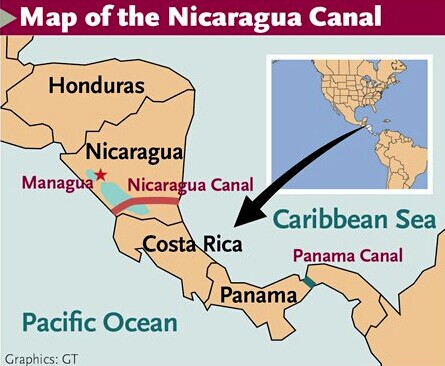

Wang Jing, chairman and CEO of HKND Group, explains to a Global Times reporter the significance of a second inter-ocean canal in Central America. Photo: Chu Daye/GT

In the mountains and rivers of Central America, work on one of the world's largest infrastructure projects is progressing as planned, driven by Chinese billionaire Wang Jing.
With a planned capacity to accommodate ships with loaded displacement of 400,000 tons, the proposed 278-kilometer-long canal that will run across the Nicaragua isthmus would probably change the landscape of the world's maritime trade, Wang, the billionaire behind the project, told the Global Times.
"The project is the largest infrastructure project ever in the history of man in terms of engineering difficulty, investment scale, workload and its global impact," Wang, chairman and CEO of the HK Nicaragua Canal Development Investment Co (HKND Group), told Global Times reporters in an exclusive interview on Thursday.
The Nicaragua Canal, which is about four times the length of the Panama Canal, will connect the Atlantic Ocean and the Pacific Ocean upon its completion. The project is estimated to cost $50 billion.
"Our canal lock is 15-meter-thick, hard steel. Imagine its size. [It'll be] the world's largest," the 41-year-old Wang said.
The Nicaragua Canal project is just one of many giant infrastructure projects commenced by Chinese around the world.
There are at least another five megaprojects that are currently being planned or under construction, including the $32 billion China-Pakistan economic corridor and the $1.7 billion Baltic Pearl Project, according to media reports.
On July 7, a Nicaraguan committee approved the route of the canal, avoiding proposed routes that pass regions under border disputes.
"Now it is pending environmental and social impacts studies, which will lead to some changes, but the big picture is set up and the canal will be completed by 2019," Wang said.
Wang's company secured a 50-year concession for the canal and an extension right of another 50 years.
A game changer
Wang said the Nicaragua Canal will be able to accommodate ships with a displacement of 400,000 tons.
"The world's leading shipbuilders have already commenced research projects to design and build ships especially for the Nicaragua Canal," Wang said.
Analysts said that currently ships with a displacement of 400,000 tons mainly carry crude and bulk cargo such as minerals, coal, and grains, but as trade develops, larger ships could be a trend.
However, there are doubts around the world about the Nicaragua Canal project, mainly focusing on its engineering difficulty and funding during the construction phase and the economic viability after completion.
Starting from the 19th century, the Spanish, the Dutch, the Americans and the French have attempted to construct an inter-ocean canal in Nicaragua, but none succeeded.
An AP report in June 2013 pointed out the terrain faced by the builders of the Nicaragua Canal would be more complex than the Panama Canal, citing Panama Canal Administrator Jorge Quijano.
"I agree with all the difficulties, but for me, these problems are temporary. As an investor, I would prefer to see the opportunities of tomorrow," Wang said. "Because if you don't, you will be a runner-up at best, you will never be the champion."
However, for the project's financing, which is around $50 billion, Wang seems quite confident.
"If you can deliver, you will find all the world's money at your disposal," Wang said, adding that he will raise the money through combined measures of cross-shareholding, bank lending and debt issuance.
Wang estimates that his company could collect several billion US dollars worth of tolls on an annual basis, but he urged investors not to lose sight of the bigger picture.
"The canal would bring huge benefits to the world's seaborne trade. It will make large-scale, low-cost, high-efficiency trade possible, unlocking trade demand between the East and the West," Wang said.
"The continuously growing Chinese economy and a rising Latin America underpin a growing global maritime transport volume," Zhang Yongfeng, a Shanghai-based shipping expert, told the Global Times Monday.
Powerful partners
As the final construction date, scheduled to begin by December this year, approaches, there is a rising number of disclosures from the partners of HKND Group.
So far, China Gezhouba Group Corporation (CGGC), a water project infrastructure giant, Xugong Group Construction Machinery Co, a construction manufacturing heavyweight, and China Railway Construction Corporation said they have joined the endeavor.
Foreign firms such as McKinsey & Company and Environmental Resource Management are also on board.
"You can count on a dozen similar announcements [like the one by CGGC] to follow," Wang said.
Wang said his partners range from central government-administered SOEs to foreign companies, and from financial institutions to equipment makers to designing and construction service providers.
"The canal project is an industrial chain. At each link of this chain, there will be an industry leader participating in this project," Wang said, noting that the weight of their stakes will be decided according to the "rule of the market."
More than just a canal
Wang dismissed speculation that the canal he is building would become a competitor to the Panama Canal.
"The Panama Canal won't fit my clients' ships. After expansion, they can only accommodate ships up to 150,000 tons. But our canal offers an alternative route for those sailing across the Panama Canal," he said.
For the locals at Nicaragua, a key concern has been the man-made canal's environmental impact, particularly on the Nicaragua Lake, the largest freshwater lake in Central America.
"We have 100-year concession rights, we will be responsible to ourselves, and we are there to build, not to destroy," Wang said.
In a master plan sent to the Global Times, which covers the time span of 2014-30, infrastructure projects such as a free trade zone, an airport, and a recreational village are also shown.
Media reports estimate that the project could create about 50,000 to 200,000 jobs during construction and afterward, significantly lifting Nicaragua's economy, where about 80 percent of the populace live on less than $2 per day.
Expenses of the project now range from $7 million to $ 20 million per month, Wang said.
"As the project goes forward, there will be more news," he said.
GT: Who is your partner?
Wang: There are a dozen of them, all big and valuable companies.
GT: How can you ensure the project gets enough funding?
Wang: If you can deliver, you will find all of the world's money at your disposal.
GT: Some say oceangoing traffic is on the decline, do we really need a new ocean-linking canal?
Wang: Such talk is nonsense. Demand for oceangoing traffic will only rise, from a long-term view.
GT: Has your friendship with the Nicaraguan president's son helped?
Wang: Our personal friendship has no sway on the business decisions concerning the canal project.
GT: So digging a canal in the "backyard of the US" does not bug you?
Wang: Free, prosperous maritime trade benefits everybody, including the US.
Copyright ©1999-2018
Chinanews.com. All rights reserved.
Reproduction in whole or in part without permission is prohibited.